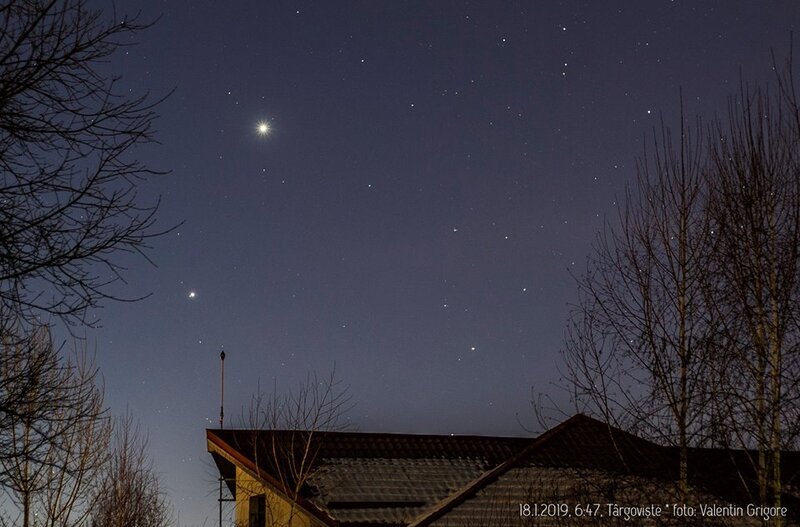POPA NAN AND OTHER SHORT STORIES BETWEEN EVENING STARS
Introductory photo Valentin Grigore
Text and photos Andrei Dorian Gheorghe
Design Florin Alexandru Stancu

This picture, taken by Valentin Grigore in 2019-01-18,
with Venus (the Evening Star in Romanian folklore)
and Jupiter (the replacer of the Evening Star when Venus absents in the sky)
made me come back in time until 2015-03-08,
when the vision of a new particular university in Bucharest surprised me.
Between two stylized evening stars,
that university was named after the titan Hyperion,
“he who does move above”,
an alternative name which had been also chosen in 1883
by the Romanian national poet Mihai Eminescu for the hero
of his masterpiece, Luceafarul (the Evening Star).
And because that university was placed on one of the old arteries,
which crossed from south to north the east of Bucharest in the 18th century,
the Popa (Priest) Nan street
(named after a local religious hero, who founded a church at that time),
I decided to walk through that zone as much as I could in 2015 and 2016
(putting together, as a fluent story, pictures taken in different days),
to breathe the healthier air of the old town.
But I remarked that the communist regime
had broken the length of the street in the 1980s,
so I began to go north from a modern block of flats,
looking especially for old buildings.
At the intersection with another old artery, the Calarasi Way
(which crossed Bucharest from the centre to the east edge),
I saw the Hyperion University again
and I stopped to open a few irresistible historical parentheses
with Saints Peter and Paul painted at the entrance.
Going east for a few minutes,
I found the Hagiu Church,
founded in the 1700s (probably by a Greek aristocrat
who had emigrated from the Ottoman Empire)
and remade in 1768 and 1872-74.
Going west for a few minutes,
I found the New Delea Church,
founded in 1761 and remade in 1790-96 and 1872-75,
and repainted around 1980.
In its new painting I could admire
an astral beam, a solar halo and a flight among the planets.
Very close, another church, Old Delea,
founded in the 17th century and remade in 1766-1768 and 1894-1898,
rich in solar motifs.
Returned to the intersection,
I continued to travel in time,
going north on the Popa Nan street.
Right near the Popa Nan Church,
founded in 1719 (at the former north-east edge of Bucharest)
and remade in 1910-18,
I remarked the house (now a school)
where one of the most talented Romania poetesses,
Magda Isanos (1916-1944),
lived her last years.
Suddenly I remembered a few verses by Magda Isanos:
“So much sun, my God, so much sun
will remain after us in the world;
trains of seasons and rains,
with hair coolly flowing …
and this grass will rise again,
and the amazed moon will identically incline
to the passing water -
but we certainly will not be for the second time…”
(from “We Die… As Tomorrow” - ADG’s translation)
So that I wanted to see the Sun
setting next to the Popa Nan Church…
Then I wanted to see the Moon over the same church,
and I did it in 2016-01-23.
On that evening, in spite of the snow,
I continued catching the Moon over the Old Delea Church…
And over the Hagiu Church…
And I decided to end the project at the New Delea Church
with two photographic poems
including two sets of three pictures
(with the Moon - 2016-01-23 -
and the sunset - 2016-03-02)
and an astro-photo-poem
(with Sirius between the spires - 2016-01-23 -,
the most spectacular cosmic painting - 2015-05-05 -,
and the Moon with Jupiter and Venus - 2015-05-26 -.
the two… Evening Stars!).
1
2
3
He who imagine a saint flying
Among the planets, resolute,
Anticipates, in fact, just
The flight of an astronaut.
Don’t think in this strange world
That everything is relative!
Under Sun, Moon, stars and planets,
Tomorrow we’ll certainly live!
*
© 2019 SARM
(Romanian Society for Meteors and Astronomy)